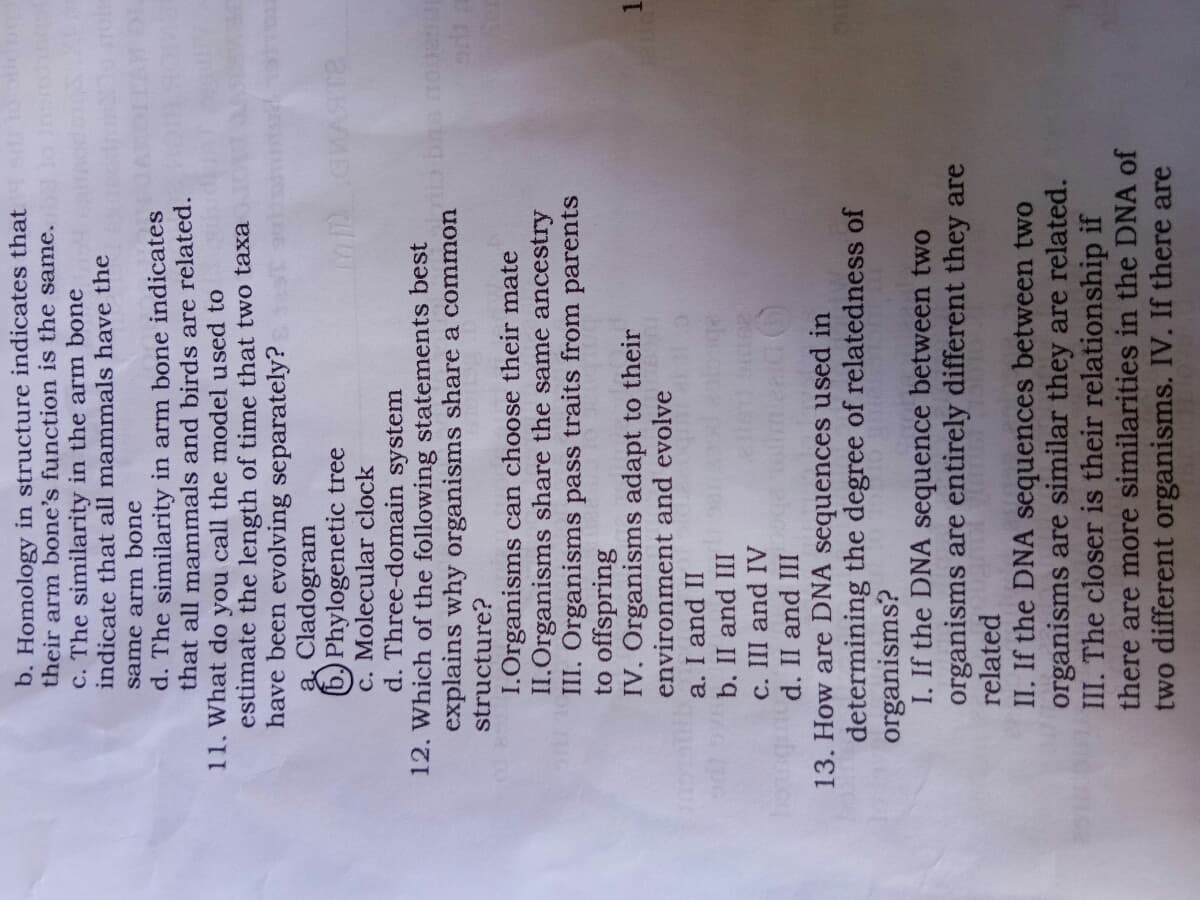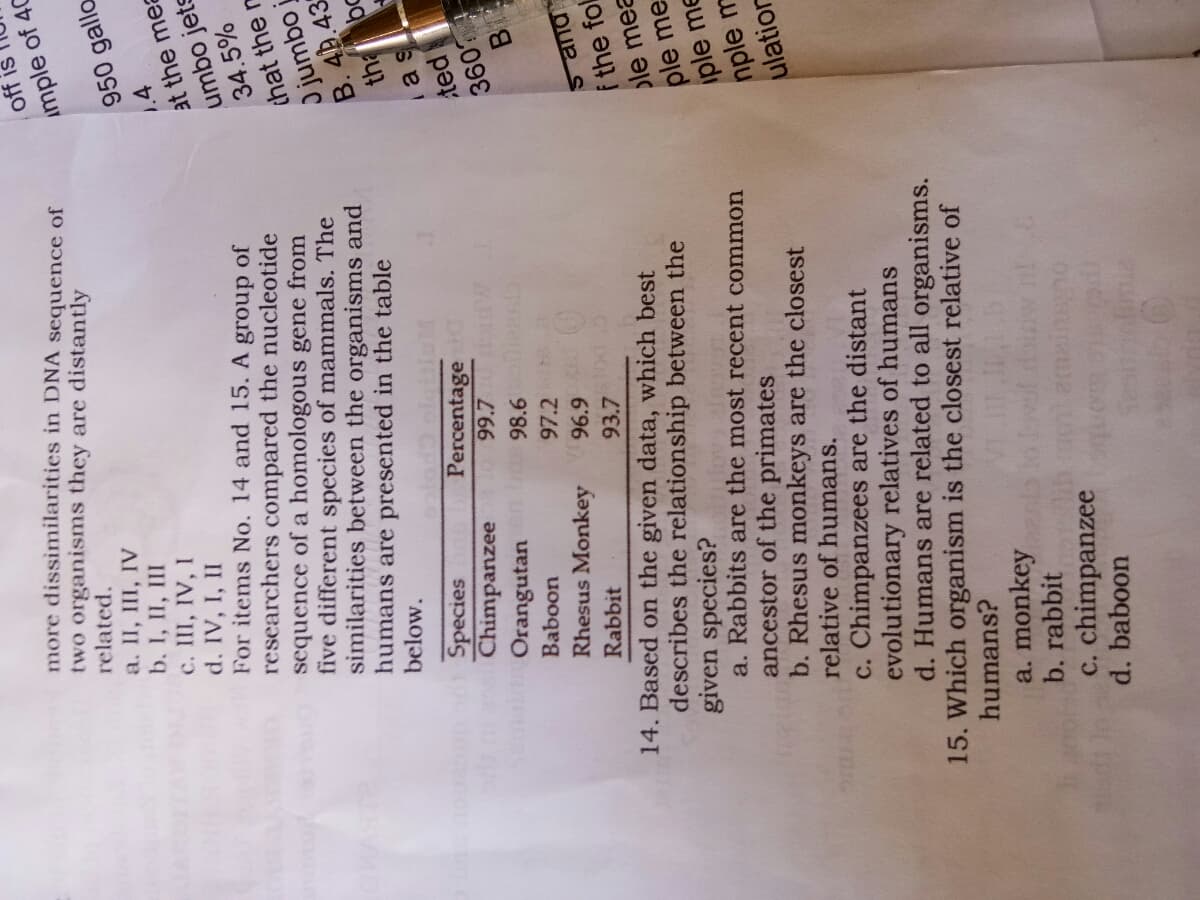have been evolving separately? a. Cladogram b) Phylogenetic tree c. Molecular clock d. Three-domain system 12. Which of the following statements best explains why organisms share a common structure? I.Organisms can choose their mate II.Organisms share the same ancestry III. Organisms pass traits from parents to offspring IV. Organisms adapt to their environment and evolve a. I and II b. II and III c. III and IV d. II and III 13. How are DNA sequences used in determining the degree of relatedness of organisms? I. If the DNA sequence between two organisms are entirely different they are related II. If the DNA sequences between two organisms are similar they are related. III. The closer is their relationship if there are more similarities in the DNA of two different organisms. IV. If there are
have been evolving separately? a. Cladogram b) Phylogenetic tree c. Molecular clock d. Three-domain system 12. Which of the following statements best explains why organisms share a common structure? I.Organisms can choose their mate II.Organisms share the same ancestry III. Organisms pass traits from parents to offspring IV. Organisms adapt to their environment and evolve a. I and II b. II and III c. III and IV d. II and III 13. How are DNA sequences used in determining the degree of relatedness of organisms? I. If the DNA sequence between two organisms are entirely different they are related II. If the DNA sequences between two organisms are similar they are related. III. The closer is their relationship if there are more similarities in the DNA of two different organisms. IV. If there are
Biology: The Dynamic Science (MindTap Course List)
4th Edition
ISBN:9781305389892
Author:Peter J. Russell, Paul E. Hertz, Beverly McMillan
Publisher:Peter J. Russell, Paul E. Hertz, Beverly McMillan
Chapter23: Paleobiology And Macroevolution
Section: Chapter Questions
Problem 4TYK
Related questions
Question
100%
Answer the number 12, 13, 14 and 15. Thank you

Transcribed Image Text:b. Homology in structure indicates that
their arm bone's function is the same.
c. The similarity in the arm bone
indicate that all mammals have the
same arm bone
d. The similarity in arm bone indicates
that all mammals and birds are related.
11. What do you call the model used to
estimate the length of time that two taxa
have been evolving separately?
a Cladogram
6) Phylogenetic tree
c. Molecular clock
d. Three-domain system
12. Which of the following statements best
explains why organisms share a common
structure?
I.Organisms can choose their mate
II.Organisms share the same ancestry
III. Organisms pass traits from parents
to offspring
IV. Organisms adapt to their
environment and evolve
a. I and II
b. II and III
c. III and IV
d. II and III
13. How are DNA sequences used in
determining the degree of relatedness of
organisms?
I. If the DNA sequence between two
organisms are entirely different they are
related
II. If the DNA sequences between two
organisms are similar they are related.
III. The closer is their relationship if
there are more similarities in the DNA of
two different organisms. IV. If there are
ICE

Transcribed Image Text:more dissimilarities in DNA sequence of
two organisms they are distantly
related.
off
imple of 40
a. II, III, IV
b. I, II, III
c. III, IV, I
d. IV, I, II
For items No. 14 and 15. A group of
researchers compared the nucleotide
sequence of a homologous gene from
five different species of mammals. The
similarities between the organisms and
humans are presented in the table
below.
950 gallo
1.4
at the mea
umbo jets
34.5%
chat the r
oquin
B. 4b.435
Species
Chimpanzee
Orangutan
Percentage
99.7
98.6
Baboon
B
Rhesus Monkey
Rabbit
93.7
14. Based on the given data, which best
describes the relationship between the
given species?
a. Rabbits are the most recent common
ancestor of the primates
b. Rhesus monkeys are the closest
relative of humans.
c. Chimpanzees are the distant
evolutionary relatives of humans
d. Humans are related to all organisms.
i the fol
ole mea
ple me
iple me
nple m
ulation
15. Which organism is the closest relative of
humans?
a. monkey
b. rabbit
c. chimpanzee
d. baboon
Alimia
Expert Solution
This question has been solved!
Explore an expertly crafted, step-by-step solution for a thorough understanding of key concepts.
Step by step
Solved in 2 steps

Knowledge Booster
Learn more about
Need a deep-dive on the concept behind this application? Look no further. Learn more about this topic, biology and related others by exploring similar questions and additional content below.Recommended textbooks for you

Biology: The Dynamic Science (MindTap Course List)
Biology
ISBN:
9781305389892
Author:
Peter J. Russell, Paul E. Hertz, Beverly McMillan
Publisher:
Cengage Learning

Biology Today and Tomorrow without Physiology (Mi…
Biology
ISBN:
9781305117396
Author:
Cecie Starr, Christine Evers, Lisa Starr
Publisher:
Cengage Learning

Human Biology (MindTap Course List)
Biology
ISBN:
9781305112100
Author:
Cecie Starr, Beverly McMillan
Publisher:
Cengage Learning

Biology: The Dynamic Science (MindTap Course List)
Biology
ISBN:
9781305389892
Author:
Peter J. Russell, Paul E. Hertz, Beverly McMillan
Publisher:
Cengage Learning

Biology Today and Tomorrow without Physiology (Mi…
Biology
ISBN:
9781305117396
Author:
Cecie Starr, Christine Evers, Lisa Starr
Publisher:
Cengage Learning

Human Biology (MindTap Course List)
Biology
ISBN:
9781305112100
Author:
Cecie Starr, Beverly McMillan
Publisher:
Cengage Learning

Biology: The Unity and Diversity of Life (MindTap…
Biology
ISBN:
9781337408332
Author:
Cecie Starr, Ralph Taggart, Christine Evers, Lisa Starr
Publisher:
Cengage Learning